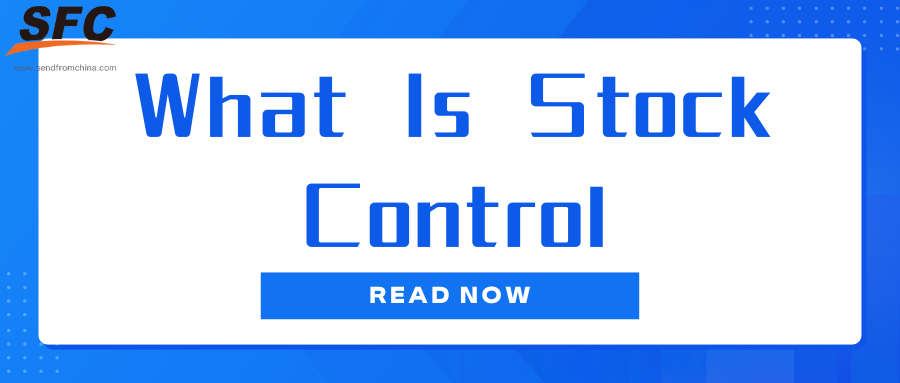Table of Contents
Get Custom eCommerce Fulfillment Service
Book a Meeting
What Is Stock Control & Why It’s Crucial for Ecommerce Success
Time: Oct 14,2025 Author: SFC Source: www.sendfromchina.com
Effective stock control is essential for ecommerce success. By implementing best practices and leveraging the right tools, businesses can optimize inventory levels, reduce costs, and enhance customer satisfaction.

This guide explores actionable strategies to streamline your stock control processes, ensuring your online store operates efficiently and meets customer demand consistently.
1. What Is Stock Control
At its core, stock control (also known as inventory control) refers to the process of managing and overseeing the quantity, location, and flow of goods in a business. It means ensuring that you have the “right product, in the right quantity, at the right time, in the right place” — without overstocking or understocking.
More specifically, stock control involves tracking inventory levels (raw materials, work-in-progress, finished goods), scheduling replenishment, recording stock movements, and making decisions that balance customer demand with carrying costs.
2. What Are Common Stock Control Methods
There is no one-size-fits-all method of stock control. Depending on the nature of your business, product types, lead times, and demand volatility, you may adopt one or more of the following methods (or hybrid approaches). Below is a survey of widely used techniques.

Just-In-Time (JIT)
With JIT, you aim to keep minimal buffer stock. Inventory is ordered only when it is needed, and ideally arrives just in time to meet consumption or sale. This minimizes holding costs and waste.
However, JIT is sensitive to supply chain disruptions: delays, quality issues, or supplier unreliability can cause stockouts.
Just-In-Case (JIC) / Safety Stock Buffer
Opposite to JIT is the just-in-case strategy, where you carry extra inventory (a safety stock) as a buffer against demand surges or supply delays. This gives resilience but at the cost of higher capital tied up.
Often, businesses combine JIT with safety stock for critical SKUs.
Economic Order Quantity (EOQ)
EOQ is a mathematical model to compute the optimal order quantity that minimizes total costs (ordering costs + holding costs). When demand is stable, EOQ helps you decide how much to order each time.
One limitation: EOQ assumes relatively stable demand and constant holding/ordering costs—less suited when demand is volatile.
Materials Requirement Planning (MRP)
MRP is more common in manufacturing: based on a bill of materials and demand forecasts, you calculate what components are needed and when to replenish them. Inventory levels are driven by production schedules.
For an e-commerce/3PL context, the analogous concept would be demand-driven replenishment and linking inventory with known orders and forecasts.
FIFO / LIFO / FEFO
FIFO (First-In, First-Out): You sell/ship the oldest stock first. This is useful especially when goods are perishable, or when you want to avoid obsolescence.
LIFO (Last-In, First-Out): The newest goods are used or sold first. It is less common in many jurisdictions (especially for physical goods) but sometimes used for accounting.
FEFO (First-Expired, First-Out): A variation of FIFO for goods with expiration dates (e.g. food, chemicals). Always pick/ship the batches closest to expiry first.
ABC Analysis (Pareto Classification)
ABC analysis divides inventory SKUs into three categories (A, B, C) based on their importance (e.g. sales volume, margin, usage). You devote more controls, tighter policies, and frequent reviews to “A” items, while “C” items may have looser control.
This helps prioritize management attention and resources.
Cycle Counting (Perpetual vs Periodic)
Instead of doing full physical stock audits infrequently, cycle counting means counting subsets of inventory regularly (e.g. daily, weekly) so discrepancies are caught early. In perpetual inventory systems, the system continuously adjusts stock levels based on transactions.
Periodic systems, by contrast, count stock at fixed intervals (e.g. monthly, quarterly). The perpetual plus cycle counting approach is more data-driven and responsive.
Vendor-Managed Inventory (VMI) / Consignment
In VMI, the supplier monitors your stock levels and replenishes automatically based on agreed thresholds. This shifts some control burden to the vendor.
Consignment inventory is similar: the supplier retains ownership until the goods are used or sold, reducing your capital risk.
Two-Bin / Kanban Systems
The two-bin system (also tied to Kanban concepts) divides inventory into two physical bins: when bin A is emptied, you reorder while using bin B in the meantime. This simple method triggers reorder signals.
In more advanced settings, kanban cards in warehouses signal movement and replenishment.
3. Benefits of Stock Control
When stock control is done well, its benefits ripple across operations, finance, customer satisfaction, and long-term strategy. Below are deeper and more nuanced advantages that go beyond the basics.

Better Cash Flow & Lower Working Capital Requirement
Reduced capital tie-up: Every unit sitting idle in your warehouse is capital you cannot invest elsewhere (marketing, R&D, expansion). Efficient stock control ensures you carry just enough stock to serve demand, freeing up cash for higher-return uses.
Improved liquidity: With more precise turnover and fewer slow movers, your cash conversion cycle shortens — meaning you spend less time waiting for inventory to convert back into cash.
Avoiding forced over-ordering at premium costs: Poor visibility often leads to panic orders at higher freight or purchase costs. Good control lets you plan and time orders more advantageously.
Cost Savings Across the Board
Lower holding costs: Warehousing, insurance, utilities, handling, depreciation, spoilage — all those costs scale with volume and time in storage. Controlling stock limits them.
Less waste, obsolescence, shrinkage: The longer products linger, the higher the risk they break, expire, become outdated, or get stolen. Better rotation, FIFO/FEFO logic, and tighter audits reduce those losses.
Reduced emergency shipping & expedited freight: Running out of stock often forces you to expedite resupply (higher shipping charges), which eats margins. Predictive replenishment avoids those spikes.
Efficiency gains in labor and operations: Staff spend less time locating mismatched items, correcting errors, reconciling discrepancies. Better organized inventory reduces wasted motion and picking errors. (Some systems report up to 25 % gains in productivity or 20 % better space usage).
Higher Order Fulfillment Rates & Fewer Lost Sales
Minimized stockouts: A major cost of mismanaging stock is missing sales — often at a high opportunity cost, especially if the customer turns to a competitor. Effective controls reduce out-of-stock occurrences.
Improved accuracy & fewer backorders: When your inventory records closely mirror physical reality, allocated stock for orders is more reliable. That means fewer cancellations or delays.
Better customer trust and loyalty: Consistent fulfillment bolsters your brand’s reliability. Over time, customers come to expect that what they order is available and delivered on time.
Enhanced Forecasting, Strategy & Data Insight
Trend spotting & demand intelligence: With clean, accurate data, you can analyze seasonality, boom/bust cycles, and SKU-level behavior. This leads to smarter procurement and product decisions.
Margin optimization: By spotting slow movers or low-margin SKUs early, you can act (discounting, bundling, phasing out) before losses accumulate.
Better negotiation with suppliers: When you know what sells, how fast, and with what consistency, you can commit to better volumes or terms — gaining cost advantages or priority in supply. NetSuite cites “better vendor terms” as a benefit of inventory control.
Scenario planning & risk mitigation: Clean data supports simulations (e.g. “if supply delays increase lead time by 20 %”) so you can build buffers or contingency plans proactively.
More Efficient Use of Warehouse Space & Asset Utilization
Slotting & layout optimization: When you know SKU velocities, you can position fast-movers near packing/shipping zones, reduce congestion, and shorten picking paths.
Maximizing storage density: Less overstocking means fewer aisles or redundant storage. You can compress your footprint or fit more SKUs in existing space.
Better use of equipment and human resources: With fewer interruptions, rework, or double handling, forklifts, conveyors, and labor are more consistently productive.
Scalability & Future-Readiness
Process standardization: As you grow, manual or ad hoc practices break down. A disciplined stock control framework scales better across multiple warehouses, regions, or global operations.
System integrations: Good stock control systems often tie into ERP, order management, procurement, and forecasting tools — enabling automated, end-to-end workflows rather than siloed islands.
Ability to support omnichannel / multi-warehouse operations: When you're handling volume across multiple locations or sales channels, robust control prevents double-selling, mismatches, and lagged updates.
Reduced Risk & Operational Visibility
Early anomaly detection: Regular cycle counts, exception reports, or variance alerts help you detect theft, damage, droughts, or supplier failures before they escalate.
Regulatory, recall, and audit readiness: For industries (food, electronics, healthcare) that require traceability (batches, lot numbers, expiry), good control ensures you can trace and recall if needed.
Greater supply chain resilience: When upstream disruptions happen (shipping delays, supplier shortages), you can respond more agilely — shifting stock, prioritizing SKUs, and buffering intelligently.
Competitive Differentiation (Especially for 3PL / Logistics Providers)
Value-added service for clients: If your 3PL operation can guarantee tight inventory control (real-time visibility, lower shrinkage, fewer errors), you become more than a warehouse — you become a logistics partner, enhancing client retention.
Selling trust & credibility: Clients choose logistics partners who reduce their operational risk. Offering mature stock control is a selling point in proposals and contracts.
Upsell opportunities: You might layer premium services (advanced analytics, vendor-managed inventory, forecasting) around stock control as revenue streams.
4. How to Improve Stock Control for Your Ecommerce Business
Improving stock control is not a one-time project; it is a continuous process of refinement and adaption. Below is a structured roadmap that ecommerce businesses can follow, from foundational steps to advanced strategies.

Centralize Inventory Visibility Across Channels & Locations
Why it matters: In multichannel operations (own store, Amazon, marketplaces, offline), inventory fragmentation is a frequent source of overselling, stock discrepancies, and blind spots.
What to do:
Adopt an omnichannel inventory platform or unified inventory management system so that stock levels are synced in real time across all sales channels. Shopify’s guidance emphasizes this as a key improvement point.
If you operate multiple warehouses or fulfillment nodes, model your available inventory across sites, and decide whether to pool stock or segregate by geography.
Use APIs or middleware to keep your storefronts, marketplaces, order management systems (OMS), and ERP in sync—so that when stock moves in one place, changes propagate everywhere.
Pitfalls to watch: Be careful with latency or synchronization delays. Even small lag (minutes) can lead to oversells during peak demand.
Invest in Good Inventory / Stock Control Software
Why it matters: Manual tracking or spreadsheets break down quickly with scale. A software backbone provides automation, error reduction, reporting, and integrations.
What to look for:
Real-time updates: stock in / out, returns, transfer between warehouses
Reorder point / safety stock logic and automatic reorder generation
Integration with sales, accounting, procurement, WMS
Reporting & analytics: turnover, slow movers, stock aging, forecast vs actual
Multi-location and multi-currency support (if operating globally)
Shopify’s “stock control” guide lists inventory software as their first recommendation.
Implementation tips:
Migrate data carefully (SKUs, historical sales, supplier info)
Run parallel for a period to validate
Train staff thoroughly—software only helps if people use it correctly
Optimize Stock Levels (Reorder Points, Safety Stocks, PAR Levels)
Finding the “sweet spot” of how much stock to hold is crucial. Too much — you waste money. Too little — you lose sales.
Key tactics:
Reorder point (ROP) formula: ROP = (daily average usage × lead time) + safety stock
Safety stock: extra buffer to absorb demand/supply fluctuations. The concept is well known in logistics and supply chain theory
PAR (Periodic Automatic Replenishment) level: set target levels from which to replenish. Nexcess discusses this as a technique.
Adjust parameters for each SKU rather than applying “one size fits all.” High-demand or high-margin SKUs may deserve more buffer; slow-movers less.
Revisit these levels periodically (quarterly or semiannual) based on actual observed sales, lead time changes, or supply risk shifts.
Caution: Over-optimism in forecasting, ignoring supplier variability, or overfitting to short-term spikes can lead to understock or overstock. Always include a buffer margin.
Classify SKUs (e.g. ABC / Pareto) & Focus Control
You cannot apply the same level of scrutiny to every SKU. ABC segmentation helps you apply efforts where they matter most.
A items (top ~10–20 % of SKUs): high sales volume, high risk or high margin. These deserve stricter monitoring, frequent reviews, tighter tolerance for errors.
B items: medium importance.
C items: low sales/low value items—looser controls, longer review cycles.
This approach is classic in materials management and is widely taught.
Application tips:
Use sales volume, revenue contribution, turnover rate, or forecast variability to rank SKUs
Use different reorder frequency, audit cycles, or safety stock rules per class
For C items, consider lighter, “just-in-case” approaches rather than full automation or tight control
Carry Out Regular Audits & Cycle Counting
Even with digital systems, physical discrepancies occur. Cycle counting is a method to catch and correct errors early, and it is far less disruptive than full shutdown inventory counts.
Cycle counting means auditing small subsets of inventory continuously (daily, weekly) rather than shutting down to count all.
Focus cycle counts more heavily on “A” SKUs (higher value or volume)
After discrepancies are detected, perform root-cause analysis (mis-picks, damage, theft, misscans) and correct process issues
Compare system stock vs physical count, reconcile differences quickly
In parallel, do periodic full physical counts (e.g. quarterly or annually) to validate the overall health of your controls.
Improve Picking, Storage & Warehouse Layout
Better stock control is not just about numbers — physical handling also matters. Inefficient layout and picking design lead to misplacement, mispicks, and time waste.
Tactics to apply:
Slotting optimization: place fast-moving SKUs nearer to packing/shipping zones; slow movers farther back
Use zoned, wave, batch picking strategies depending on order profile
Keep picking paths efficient; minimize cross-traffic and backtracking
Use bin/slot-level control in your WMS to know exactly where each unit is stored
When transferring inventory between zones, scan or log movements to keep system and floor synchronized
Demand Forecasting & Analytics
Better forecasts lead to smarter replenishment, fewer surprises, and tighter stock control.
Approaches:
Use historical sales data, seasonality, trends, promotional events, and macro indicators
Apply time series models (moving average, exponential smoothing, ARIMA) or more advanced machine-learning methods
Incorporate external signals (market trends, Google search behavior, competitive activity)
Use forecast error metrics (MAPE, RMSE) to monitor and refine
Align forecast with inventory buffer logic: for SKUs with more forecast uncertainty, carry higher safety buffer
Retailers and logistics researchers (e.g. JD.com) are deploying optimized allocation and inventory models that integrate forecasting and location allocation.
Note: Forecasts are not perfect. Always monitor variance and adjust parameters. Avoid overfitting to noise.
Automate Replenishment Workflows & Alerts
Automation reduces latency, human error, and oversight gaps.
Program automatic reorder triggers when stock hits reorder points
Use threshold alerts for low stock, overstock, aging inventory, or expired goods
Make sure the system can generate purchase orders (POs) or send restock requests to suppliers automatically
Integrate alerts with notifications (email, dashboards, mobile) so stakeholders act quickly
For multi-warehouse setups, automate inter-warehouse transfers when one site has surplus and another a deficit
Partner with Reliable, Flexible Suppliers
Your control over stock is only as good as the upstream supply reliability.
Build relationships with multiple suppliers to reduce single-source risk
Negotiate lead-time flexibility, buffer stock agreements, or partial shipping options
Where feasible, set up vendor-managed inventory (VMI) or consignment for particular SKUs — handing some control to suppliers while you maintain visibility
Require suppliers to notify lead-time changes, delays, or forecasts in advance
Do periodic supplier performance reviews (on-time delivery, defect rate, lead time consistency)
Handle Returns, Damages & Reverse Logistics Explicitly
Returns and damaged goods are a reality, especially in ecommerce. If poorly handled, they undermine your stock numbers.
Build processes to inspect, refurbish (if possible), and re-enter returned stock into inventory
Tag “quarantine” zone for inspecting returns before restocking
Log write-offs or scrap for irreparable goods
Adjust forecasts or reorder logic to anticipate typical return rates
In your system, distinguish between sellable returns, defective returns, and items requiring disposal
Monitor KPIs & Use Continuous Improvement
You can’t manage what you don’t measure. A disciplined metrics framework drives feedback loops and helps you refine over time.
Recommended KPIs:
Inventory turnover ratio (how many times inventory sells per period)
Days of inventory on hand (DOH)
Stock-out rate / fill rate
Forecast error (e.g. MAPE)
Pick error rate / pick accuracy
Shrinkage or discrepancy rate (differences between system vs physical)
Value of excess / obsolete inventory
Order-to-ship cycle time
5. Challenges in Stock Control
While good stock control offers many benefits, it’s not without difficulties, especially in dynamic ecommerce and third-party logistics environments. Below are common challenges to watch for and plan around.

Demand Volatility & Forecast Errors
Unexpected spikes, seasonality, or trend shifts can invalidate forecasts and lead to stockouts or overstock.
Supply Chain Disruptions
Shipping delays, supplier quality issues, customs holdups, or transportation problems can break the linkage between your ordering plan and execution.
Multiple Channels & SKUs Complexity
When you sell via multiple marketplaces and platforms, SKU proliferation and channel synchronization create complexity and risk of overselling or discrepancies.
Human Errors & Shrinkage
Miscounts, data entry mistakes, theft, damage, or misplacement can undermine your system’s accuracy over time.
Integration Gaps
If your inventory system (or WMS) doesn’t integrate well with sales, procurement, ERP, or logistics systems, data silos or delays may arise.
Cost vs Benefit Tradeoffs
Investing in automation, WMS, RFID, or more frequent audits yields benefit — but at cost. Smaller SKUs or low-margin goods may not justify high-tech controls.
Obsolescence or Product Lifecycle Changes
In fast-changing markets, product lines may phase out or trends shift, leaving slow-moving inventory. Managing obsolescence is a constant risk.
Managing Returns, Damaged or Lost Stock
Returned items, defective returns, or damaged goods require reverse logistics and often complicate stock reconciliation.
Scaling Pains
As your volume grows, manual steps or legacy systems that worked at smaller scale may break down. Complexity multiplies, and processes must evolve.
Understanding these challenges ahead of time will help you design better buffers, contingencies, and scalable systems.
6. Improving Stock Control with SFC WMS
As SendFromChina (SFC), you offer logistics and warehouse services. One of your differentiators can be a robust internal or client-facing Warehouse Management System (WMS) tailored to third-party logistics. Below is a discussion of how SFC’s WMS can be leveraged to enhance stock control — both for your internal operations and as a value added service to your e-commerce clients.

How SFC WMS Enhances Internal Stock Control
Unified Dashboard for Client Inventories: From your WMS interface, you should be able to monitor all clients’ stock levels, inbound/outbound flows, reorder status, and alerts. This gives you control and allows you to spot anomalies early.
Real-Time Stock Updates: Whenever goods arrive, are picked, packed, or shipped, the system updates quantities, ensuring what clients see and what physically exists remain in sync.
Zone & Slotting Optimization: The WMS can recommend which items go into which zone or shelf based on turnover velocity or size. Frequently picked items should be close to packing stations; slow movers can go further back.
Automated Picking & Replenishment Logic: The WMS can automatically tell staff which SKUs to replenish from bulk racks to pick faces, or even schedule restock waves during off-peak times.
Error Checking & Validation: Before dispatch, the system can validate picks against orders, catching errors or discrepancies. Barcodes or scanning ensure that wrong items are seldom shipped.
Cycle Count Scheduling & Audit Support: Within the WMS, you can schedule cycle counts, track when counts diverge from expected records, and trigger investigations.
Batch / Lot / Expiry Tracking: For products with batch numbers or expiration dates, SFC WMS can incorporate these into picking logic (FEFO), and flag near-expiry items for priority dispatch.
Client Portal / Transparency: Offer clients visibility (e.g. via web portal or API) into their stock at SFC warehouses: levels, inbounds, outbounds, alerts. Transparency builds trust.
Integration with Supply Chain Partners: Link your WMS with client order systems, procurement systems, or upstream suppliers so that stock replenishment is more coordinated.
Scalable & Modular Design: SFC’s WMS should be modular so you can roll out features (e.g. automation, analytics) progressively without disrupting operations.
By implementing and optimizing SFC WMS in these ways, you convert stock control from a cost center into a service differentiator. Clients see you not just as storage, but a logistics partner who improves their inventory efficiency and reliability.
7. Conclusion
Good stock control is the backbone of efficient commerce in the digital age. It is not merely about “keeping count” — it is a strategic balance between demand, cost, service, and risk. For ecommerce businesses, poor control can result in lost sales, wasted capital, or reputational damage. For a logistics provider like SendFromChina, demonstrating superior stock control via your own WMS (and offering it to clients) can transform your positioning in a competitive market.
8. FAQs
1. What’s the difference between stock control and inventory management?
They are often used interchangeably. Stock control usually focuses on controlling levels, flow, and tracking; inventory management is broader (procurement, forecasting, turnover).2. How often should I do stock counts?
Frequent small “cycle counts” are better (daily / weekly) for critical SKUs; full counts can be quarterly or annually, depending on size.3. Is JIT always better than holding safety stock?
Not always. JIT minimizes costs but is risky when supply is volatile. Many businesses use a hybrid: just-in-time plus a safety buffer for critical items.4. Can small ecommerce operations use a WMS?
Yes — many cloud / SaaS WMS solutions are designed for small to mid-scale operations. The benefits often outweigh cost if order volume is growing.5. How do I choose which stock control method to use?
Start by analyzing your demand patterns, lead time stability, SKU diversity, margin structure, and risk tolerance. Then pilot one or two methods (e.g. EOQ + safety stock, or JIT for fast movers) and refine over time. Post Views:390
Post Views:390
Copyright statement: The copyright of this article belongs to the original author. Please indicate the source for reprinting.
Previous Post
Fulfillment Center Shortage: What It Is and How You Should React
Next Post
TAGS
Hot Research
Recent News
- Third Party Logistics Definition, Process, and Advantages
- What Is Ecommerce Fulfillment? The Definition, Process, and Benefits
- Where Does Shein Ship From
- Optimize Pet Product Fulfillment With 3PL Services for Your Ecommerce Store
- The Ultimate Guide to Warehouse Sorting for Modern Logistics Operations
Get Custom eCommerce Fulfillment Service
Book a Meeting
Get a Custom China Fulfillment Solution with FREE Storage for 30 Days
 Want to know about our services, fees or receive a custom quote?
Want to know about our services, fees or receive a custom quote?
 Please fill out the form on the right and we will get back to you within a business day.
Please fill out the form on the right and we will get back to you within a business day.
 The more information you provide, the better our initial response
will be.
The more information you provide, the better our initial response
will be.





 TAGS:
TAGS: